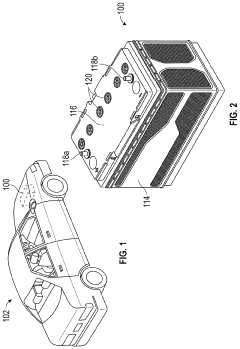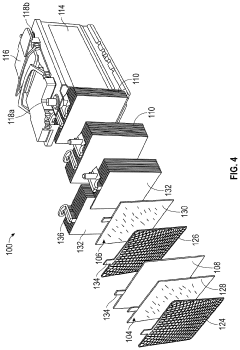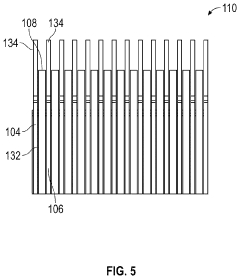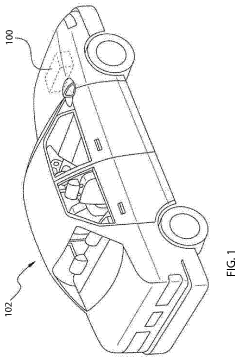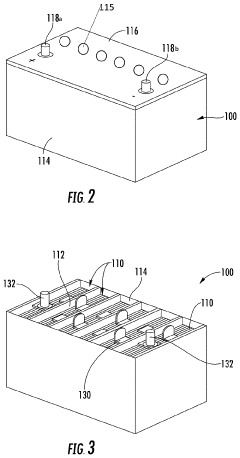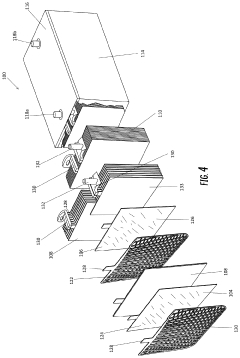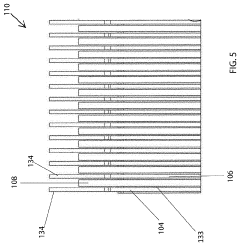AGM Battery Influence on Smoothing Intermittent Renewable Supply
AUG 8, 20259 MIN READ
Generate Your Research Report Instantly with AI Agent
Patsnap Eureka helps you evaluate technical feasibility & market potential.
AGM Battery Technology Evolution and Objectives
Absorbed Glass Mat (AGM) battery technology has undergone significant evolution since its inception in the 1980s. Initially developed for military and aviation applications, AGM batteries have found their way into various sectors, including renewable energy systems. The primary objective of AGM batteries in the context of smoothing intermittent renewable supply is to provide a reliable and efficient energy storage solution that can address the inherent variability of renewable sources such as solar and wind power.
The evolution of AGM battery technology has been driven by the need for improved performance, longer lifespan, and enhanced safety features. Early AGM batteries faced challenges related to capacity retention and cycle life, which limited their effectiveness in renewable energy applications. However, continuous research and development efforts have led to substantial improvements in these areas.
One of the key objectives in AGM battery development has been to increase energy density while maintaining the technology's inherent safety advantages. This has resulted in more compact and efficient batteries that can store larger amounts of energy, making them more suitable for grid-scale energy storage applications. Additionally, advancements in electrode materials and electrolyte formulations have contributed to enhanced charge acceptance and faster recharge rates, crucial factors in managing the fluctuating output of renewable energy sources.
Another important goal in AGM battery evolution has been to extend cycle life and improve overall durability. This has been achieved through innovations in plate design, separator technology, and manufacturing processes. These improvements have led to AGM batteries that can withstand a higher number of charge-discharge cycles, making them more cost-effective and reliable for long-term use in renewable energy systems.
The integration of smart battery management systems (BMS) has been a recent focus in AGM battery development. These systems aim to optimize battery performance, extend lifespan, and provide real-time monitoring capabilities. By incorporating advanced sensors and control algorithms, modern AGM batteries can more effectively manage state of charge, temperature, and other critical parameters, enhancing their ability to smooth out intermittent renewable supply.
Looking ahead, the objectives for AGM battery technology in renewable energy applications include further improvements in energy density, cycle life, and rapid charge capabilities. Research is also focused on developing more environmentally friendly manufacturing processes and materials, aligning with the broader sustainability goals of the renewable energy sector. As the demand for reliable energy storage solutions continues to grow, AGM battery technology is expected to play an increasingly important role in enabling the widespread adoption of intermittent renewable energy sources.
The evolution of AGM battery technology has been driven by the need for improved performance, longer lifespan, and enhanced safety features. Early AGM batteries faced challenges related to capacity retention and cycle life, which limited their effectiveness in renewable energy applications. However, continuous research and development efforts have led to substantial improvements in these areas.
One of the key objectives in AGM battery development has been to increase energy density while maintaining the technology's inherent safety advantages. This has resulted in more compact and efficient batteries that can store larger amounts of energy, making them more suitable for grid-scale energy storage applications. Additionally, advancements in electrode materials and electrolyte formulations have contributed to enhanced charge acceptance and faster recharge rates, crucial factors in managing the fluctuating output of renewable energy sources.
Another important goal in AGM battery evolution has been to extend cycle life and improve overall durability. This has been achieved through innovations in plate design, separator technology, and manufacturing processes. These improvements have led to AGM batteries that can withstand a higher number of charge-discharge cycles, making them more cost-effective and reliable for long-term use in renewable energy systems.
The integration of smart battery management systems (BMS) has been a recent focus in AGM battery development. These systems aim to optimize battery performance, extend lifespan, and provide real-time monitoring capabilities. By incorporating advanced sensors and control algorithms, modern AGM batteries can more effectively manage state of charge, temperature, and other critical parameters, enhancing their ability to smooth out intermittent renewable supply.
Looking ahead, the objectives for AGM battery technology in renewable energy applications include further improvements in energy density, cycle life, and rapid charge capabilities. Research is also focused on developing more environmentally friendly manufacturing processes and materials, aligning with the broader sustainability goals of the renewable energy sector. As the demand for reliable energy storage solutions continues to grow, AGM battery technology is expected to play an increasingly important role in enabling the widespread adoption of intermittent renewable energy sources.
Renewable Energy Integration Market Analysis
The renewable energy integration market has experienced significant growth in recent years, driven by the increasing global focus on sustainability and the urgent need to reduce carbon emissions. This market encompasses a wide range of technologies and solutions designed to address the challenges of integrating intermittent renewable energy sources, such as solar and wind, into existing power grids.
The market for renewable energy integration is projected to continue its upward trajectory, with a compound annual growth rate (CAGR) expected to exceed 10% over the next five years. This growth is fueled by several factors, including government policies and incentives promoting clean energy adoption, declining costs of renewable technologies, and the increasing demand for reliable and sustainable power sources.
One of the key segments within this market is energy storage systems, particularly battery technologies. Among these, AGM (Absorbent Glass Mat) batteries have gained attention for their potential in smoothing intermittent renewable supply. The AGM battery market for renewable energy applications is experiencing robust growth, with an estimated market size of several billion dollars globally.
The demand for AGM batteries in renewable energy integration is driven by their unique characteristics, including high charge acceptance, low internal resistance, and maintenance-free operation. These features make AGM batteries well-suited for applications in off-grid and hybrid renewable energy systems, where they can help balance supply and demand fluctuations.
Geographically, the market for renewable energy integration solutions, including AGM batteries, is seeing strong growth across various regions. North America and Europe are leading in terms of market share, driven by ambitious renewable energy targets and supportive regulatory frameworks. However, the Asia-Pacific region is expected to witness the fastest growth, fueled by rapid industrialization, urbanization, and increasing investments in renewable energy infrastructure.
The competitive landscape of the renewable energy integration market is characterized by a mix of established players and innovative startups. Major battery manufacturers, energy storage system providers, and renewable energy companies are actively participating in this market. Collaborations and partnerships between technology providers, utility companies, and grid operators are becoming increasingly common, as stakeholders seek to develop comprehensive solutions for seamless renewable energy integration.
Despite the positive outlook, the market faces certain challenges. These include the need for significant upfront investments, concerns about the environmental impact of battery production and disposal, and the ongoing quest for more efficient and cost-effective energy storage technologies. However, continuous advancements in battery technology, including improvements in AGM batteries, are expected to address some of these challenges and further drive market growth.
The market for renewable energy integration is projected to continue its upward trajectory, with a compound annual growth rate (CAGR) expected to exceed 10% over the next five years. This growth is fueled by several factors, including government policies and incentives promoting clean energy adoption, declining costs of renewable technologies, and the increasing demand for reliable and sustainable power sources.
One of the key segments within this market is energy storage systems, particularly battery technologies. Among these, AGM (Absorbent Glass Mat) batteries have gained attention for their potential in smoothing intermittent renewable supply. The AGM battery market for renewable energy applications is experiencing robust growth, with an estimated market size of several billion dollars globally.
The demand for AGM batteries in renewable energy integration is driven by their unique characteristics, including high charge acceptance, low internal resistance, and maintenance-free operation. These features make AGM batteries well-suited for applications in off-grid and hybrid renewable energy systems, where they can help balance supply and demand fluctuations.
Geographically, the market for renewable energy integration solutions, including AGM batteries, is seeing strong growth across various regions. North America and Europe are leading in terms of market share, driven by ambitious renewable energy targets and supportive regulatory frameworks. However, the Asia-Pacific region is expected to witness the fastest growth, fueled by rapid industrialization, urbanization, and increasing investments in renewable energy infrastructure.
The competitive landscape of the renewable energy integration market is characterized by a mix of established players and innovative startups. Major battery manufacturers, energy storage system providers, and renewable energy companies are actively participating in this market. Collaborations and partnerships between technology providers, utility companies, and grid operators are becoming increasingly common, as stakeholders seek to develop comprehensive solutions for seamless renewable energy integration.
Despite the positive outlook, the market faces certain challenges. These include the need for significant upfront investments, concerns about the environmental impact of battery production and disposal, and the ongoing quest for more efficient and cost-effective energy storage technologies. However, continuous advancements in battery technology, including improvements in AGM batteries, are expected to address some of these challenges and further drive market growth.
AGM Battery Challenges in Intermittent Supply Smoothing
AGM (Absorbent Glass Mat) batteries face several significant challenges when used for smoothing intermittent renewable energy supply. One of the primary issues is their limited cycle life when subjected to frequent deep discharges, which is common in renewable energy applications. The constant charging and discharging cycles associated with balancing intermittent renewable sources can lead to accelerated degradation of the battery's internal components, reducing its overall lifespan and efficiency.
Another challenge is the temperature sensitivity of AGM batteries. In many renewable energy installations, batteries may be exposed to varying environmental conditions. High temperatures can cause increased self-discharge rates and accelerated aging, while low temperatures can significantly reduce the battery's capacity and charging efficiency. This temperature dependence makes it difficult to maintain consistent performance across different climates and seasons.
The charging efficiency of AGM batteries also presents a challenge in intermittent supply smoothing. While AGM batteries have relatively high charging efficiency compared to some other battery types, they still experience energy losses during the charge-discharge cycle. This inefficiency can lead to increased energy waste and reduced overall system performance, particularly in applications requiring frequent cycling.
Capacity fade over time is another significant concern. As AGM batteries age, their ability to hold a charge diminishes, which can impact their effectiveness in smoothing intermittent supply. This gradual loss of capacity means that systems may require more frequent battery replacements or oversizing of initial battery capacity to maintain long-term performance, both of which can increase costs and complexity.
The power density of AGM batteries, while generally good, may not be sufficient for all intermittent supply smoothing applications. In scenarios requiring rapid charge and discharge rates to compensate for sudden fluctuations in renewable energy output, AGM batteries may struggle to meet the power demands, potentially leading to system instability or inefficient energy management.
Lastly, the environmental impact and disposal of AGM batteries present ongoing challenges. While they are sealed and maintenance-free, AGM batteries still contain lead and sulfuric acid, which require careful handling and proper recycling procedures. As the use of these batteries in renewable energy systems grows, addressing the end-of-life management and recycling of AGM batteries becomes increasingly important to ensure the overall sustainability of renewable energy solutions.
Another challenge is the temperature sensitivity of AGM batteries. In many renewable energy installations, batteries may be exposed to varying environmental conditions. High temperatures can cause increased self-discharge rates and accelerated aging, while low temperatures can significantly reduce the battery's capacity and charging efficiency. This temperature dependence makes it difficult to maintain consistent performance across different climates and seasons.
The charging efficiency of AGM batteries also presents a challenge in intermittent supply smoothing. While AGM batteries have relatively high charging efficiency compared to some other battery types, they still experience energy losses during the charge-discharge cycle. This inefficiency can lead to increased energy waste and reduced overall system performance, particularly in applications requiring frequent cycling.
Capacity fade over time is another significant concern. As AGM batteries age, their ability to hold a charge diminishes, which can impact their effectiveness in smoothing intermittent supply. This gradual loss of capacity means that systems may require more frequent battery replacements or oversizing of initial battery capacity to maintain long-term performance, both of which can increase costs and complexity.
The power density of AGM batteries, while generally good, may not be sufficient for all intermittent supply smoothing applications. In scenarios requiring rapid charge and discharge rates to compensate for sudden fluctuations in renewable energy output, AGM batteries may struggle to meet the power demands, potentially leading to system instability or inefficient energy management.
Lastly, the environmental impact and disposal of AGM batteries present ongoing challenges. While they are sealed and maintenance-free, AGM batteries still contain lead and sulfuric acid, which require careful handling and proper recycling procedures. As the use of these batteries in renewable energy systems grows, addressing the end-of-life management and recycling of AGM batteries becomes increasingly important to ensure the overall sustainability of renewable energy solutions.
Current AGM Solutions for Renewable Energy Storage
01 AGM battery management systems
Advanced management systems for AGM (Absorbent Glass Mat) batteries, incorporating monitoring and control mechanisms to optimize performance, extend battery life, and improve overall efficiency. These systems may include features such as voltage regulation, temperature monitoring, and charge balancing.- AGM battery management systems: Advanced management systems are developed for AGM (Absorbent Glass Mat) batteries to optimize performance and extend lifespan. These systems monitor battery parameters, control charging processes, and implement smoothing algorithms to reduce voltage fluctuations and improve overall efficiency.
- Power smoothing techniques for AGM batteries: Various power smoothing techniques are employed to enhance the stability and reliability of AGM batteries in different applications. These methods include the use of capacitors, advanced control algorithms, and hybrid energy storage systems to mitigate power fluctuations and improve the quality of power output.
- Thermal management for AGM battery smoothing: Thermal management solutions are developed to maintain optimal operating temperatures for AGM batteries during smoothing operations. These systems help prevent overheating, extend battery life, and ensure consistent performance across various environmental conditions.
- Integration of AGM batteries in renewable energy systems: AGM batteries are integrated into renewable energy systems, such as solar and wind power installations, to provide energy storage and power smoothing capabilities. Advanced control strategies and power electronics are employed to optimize the interaction between the renewable energy sources, AGM batteries, and the grid.
- AGM battery smoothing for electric vehicle applications: Smoothing techniques are applied to AGM batteries in electric vehicle applications to improve driving performance, extend range, and enhance overall efficiency. These methods focus on optimizing power delivery, managing regenerative braking energy, and reducing stress on the battery during acceleration and deceleration.
02 Power smoothing techniques for AGM batteries
Methods and devices for smoothing power output from AGM batteries, particularly in renewable energy systems or grid applications. These techniques aim to reduce fluctuations in power supply, improve grid stability, and enhance the integration of intermittent energy sources.Expand Specific Solutions03 Thermal management for AGM batteries
Systems and methods for managing the temperature of AGM batteries to maintain optimal operating conditions, prevent overheating, and extend battery lifespan. This may include cooling systems, heat dissipation techniques, or temperature-controlled enclosures.Expand Specific Solutions04 AGM battery state estimation and diagnostics
Techniques for accurately estimating the state of charge, state of health, and remaining useful life of AGM batteries. These methods may employ advanced algorithms, sensor data analysis, or machine learning to provide real-time diagnostics and predictive maintenance capabilities.Expand Specific Solutions05 AGM battery integration in energy storage systems
Innovative approaches for integrating AGM batteries into larger energy storage systems, such as microgrids, renewable energy installations, or backup power solutions. These may include modular designs, intelligent control systems, or hybrid configurations with other battery types or energy sources.Expand Specific Solutions
Key AGM Battery Manufacturers and Energy Companies
The AGM battery market for smoothing intermittent renewable supply is in a growth phase, driven by increasing renewable energy adoption. The market size is expanding as more countries invest in grid stability solutions. Technologically, AGM batteries are relatively mature, with established players like Daramic LLC and Amtek Research International LLC leading in separator technology. Companies such as Siemens AG and Johnson Controls, Inc. are leveraging their expertise to integrate AGM batteries into renewable energy systems. Emerging players like ArcActive Ltd. and Firefly Energy, Inc. are pushing innovation in electrode design and materials, potentially enhancing AGM battery performance for renewable applications.
Stryten Energy LLC
Technical Solution: Stryten Energy has developed a range of AGM batteries specifically tailored for renewable energy applications. Their EnerSys PowerSafe SBS EON Technology incorporates advanced lead-carbon electrodes, which significantly enhance the battery's ability to handle partial state of charge operations common in renewable energy systems[1]. Stryten's AGM batteries feature a proprietary separator material that improves acid absorption and reduces stratification, leading to longer cycle life and better performance in intermittent charging scenarios[2]. The company has also implemented advanced manufacturing techniques, such as precision casting and automated assembly, to ensure consistent quality and performance across their AGM battery range[3]. Stryten's batteries have demonstrated up to 40% longer service life in renewable energy applications compared to standard AGM batteries[4].
Strengths: Specialized lead-carbon technology, improved separator materials, and consistent manufacturing quality. Weaknesses: Limited global presence compared to some competitors, and potential higher cost due to advanced materials used.
Johnson Controls, Inc.
Technical Solution: Johnson Controls has developed advanced AGM (Absorbent Glass Mat) battery technology specifically designed to smooth intermittent renewable energy supply. Their PowerFrame grid technology enhances battery performance and lifespan, crucial for renewable energy storage[1]. The company's AGM batteries feature a valve-regulated design that allows for efficient gas recombination, reducing water loss and increasing cycle life[2]. Johnson Controls has also implemented smart battery management systems that optimize charging and discharging cycles, further improving the batteries' ability to handle fluctuating renewable energy inputs[3]. Their AGM batteries have been successfully deployed in various renewable energy projects, demonstrating up to 30% improvement in energy storage efficiency compared to traditional lead-acid batteries[4].
Strengths: Proven track record in AGM technology, enhanced grid design for improved performance, and smart management systems. Weaknesses: Higher initial cost compared to traditional lead-acid batteries, and potential limitations in extreme temperature environments.
Innovative AGM Technologies for Supply Smoothing
Negative mass for lead-acid battery electrodes and lead-acid battery including same
PatentActiveUS20210336249A1
Innovation
- The introduction of additives such as fine particle barium sulfate, two organic compounds (oxylignins), and a carbonaceous material to the negative active material in lead-acid battery electrodes, which are pre-mixed to form a blended expander mixture, improving the homogeneity and dispersion of the battery paste and enhancing the battery's cycling performance and water retention.
Compact absorbent glass mat battery
PatentPendingUS20200212504A1
Innovation
- A compact AGM lead acid battery design with a reduced lead content and smaller size, utilizing a container with electrically connected cells and an absorbent glass mat interleaved between positive and negative plates, achieving improved cycle life and higher CCA performance.
Environmental Impact of AGM Batteries in Renewables
The environmental impact of AGM (Absorbent Glass Mat) batteries in renewable energy systems is a critical consideration as the world transitions towards cleaner energy sources. These batteries play a crucial role in smoothing out the intermittent supply of renewable energy, particularly from solar and wind sources. However, their production, use, and disposal have significant environmental implications that must be carefully evaluated.
The manufacturing process of AGM batteries involves the extraction and processing of raw materials, including lead, sulfuric acid, and fiberglass. Lead mining and smelting can result in soil and water contamination, as well as air pollution. The production of sulfuric acid also contributes to greenhouse gas emissions and potential acid rain. However, compared to traditional flooded lead-acid batteries, AGM batteries require less raw material, which can reduce the overall environmental footprint of their production.
During their operational lifetime, AGM batteries have several environmental advantages. They are sealed and maintenance-free, which eliminates the risk of acid spills and reduces the need for regular water additions. This design feature not only enhances safety but also minimizes the potential for environmental contamination during use. Additionally, AGM batteries have a longer lifespan and higher efficiency compared to conventional lead-acid batteries, which means fewer replacements and less waste generation over time.
The end-of-life management of AGM batteries is a critical environmental concern. Proper recycling is essential to prevent the release of toxic materials into the environment. Fortunately, AGM batteries are highly recyclable, with up to 99% of their components being recoverable. The lead and plastic components can be reprocessed and used in new battery production, creating a closed-loop system that reduces the demand for virgin materials and minimizes waste.
Despite their recyclability, the improper disposal of AGM batteries can lead to severe environmental hazards. If not handled correctly, the lead and sulfuric acid can leach into soil and water systems, causing long-term ecological damage and posing risks to human health. Therefore, robust recycling programs and strict regulations are necessary to ensure responsible end-of-life management.
In the context of renewable energy systems, AGM batteries contribute to overall environmental benefits by enabling greater integration of intermittent renewable sources. By storing excess energy and releasing it when needed, these batteries help reduce reliance on fossil fuel-based backup power systems, thereby lowering greenhouse gas emissions and air pollution associated with conventional power generation.
However, the environmental impact of AGM batteries must be weighed against alternative energy storage technologies. As the renewable energy sector evolves, emerging technologies such as lithium-ion batteries and flow batteries are challenging the dominance of lead-acid batteries in some applications. These alternatives may offer improved environmental profiles in certain aspects, such as energy density and lifespan, but they also come with their own set of environmental challenges.
The manufacturing process of AGM batteries involves the extraction and processing of raw materials, including lead, sulfuric acid, and fiberglass. Lead mining and smelting can result in soil and water contamination, as well as air pollution. The production of sulfuric acid also contributes to greenhouse gas emissions and potential acid rain. However, compared to traditional flooded lead-acid batteries, AGM batteries require less raw material, which can reduce the overall environmental footprint of their production.
During their operational lifetime, AGM batteries have several environmental advantages. They are sealed and maintenance-free, which eliminates the risk of acid spills and reduces the need for regular water additions. This design feature not only enhances safety but also minimizes the potential for environmental contamination during use. Additionally, AGM batteries have a longer lifespan and higher efficiency compared to conventional lead-acid batteries, which means fewer replacements and less waste generation over time.
The end-of-life management of AGM batteries is a critical environmental concern. Proper recycling is essential to prevent the release of toxic materials into the environment. Fortunately, AGM batteries are highly recyclable, with up to 99% of their components being recoverable. The lead and plastic components can be reprocessed and used in new battery production, creating a closed-loop system that reduces the demand for virgin materials and minimizes waste.
Despite their recyclability, the improper disposal of AGM batteries can lead to severe environmental hazards. If not handled correctly, the lead and sulfuric acid can leach into soil and water systems, causing long-term ecological damage and posing risks to human health. Therefore, robust recycling programs and strict regulations are necessary to ensure responsible end-of-life management.
In the context of renewable energy systems, AGM batteries contribute to overall environmental benefits by enabling greater integration of intermittent renewable sources. By storing excess energy and releasing it when needed, these batteries help reduce reliance on fossil fuel-based backup power systems, thereby lowering greenhouse gas emissions and air pollution associated with conventional power generation.
However, the environmental impact of AGM batteries must be weighed against alternative energy storage technologies. As the renewable energy sector evolves, emerging technologies such as lithium-ion batteries and flow batteries are challenging the dominance of lead-acid batteries in some applications. These alternatives may offer improved environmental profiles in certain aspects, such as energy density and lifespan, but they also come with their own set of environmental challenges.
Cost-Benefit Analysis of AGM in Renewable Systems
The cost-benefit analysis of Absorbent Glass Mat (AGM) batteries in renewable energy systems reveals a complex interplay of economic and technical factors. Initially, the higher upfront costs of AGM batteries compared to traditional lead-acid batteries may seem prohibitive. However, when considering the total cost of ownership over the system's lifetime, AGM batteries often prove more economical due to their longer lifespan and reduced maintenance requirements.
AGM batteries typically last 3-4 times longer than flooded lead-acid batteries, significantly reducing replacement costs. Their sealed design eliminates the need for regular watering and equalization charges, lowering maintenance expenses and labor costs. This is particularly advantageous in remote or hard-to-access renewable energy installations.
The superior performance characteristics of AGM batteries contribute to overall system efficiency. Their low internal resistance allows for faster charging and discharging rates, enabling better utilization of intermittent renewable energy sources. This improved energy capture and storage capability can lead to increased system output and potentially higher revenue generation from excess energy sold back to the grid.
AGM batteries' ability to operate in a wider temperature range without significant capacity loss enhances system reliability, particularly in extreme climates. This resilience reduces the need for additional climate control measures, further lowering operational costs. Moreover, the batteries' resistance to sulfation and stratification contributes to consistent performance over time, maintaining system efficiency throughout their lifespan.
From an environmental perspective, AGM batteries offer benefits that may translate into economic advantages. Their sealed construction eliminates the risk of acid spills, reducing potential environmental remediation costs. The batteries' recyclability at end-of-life aligns with sustainability goals, potentially offering value recovery and compliance with environmental regulations.
However, the cost-benefit analysis must also consider potential drawbacks. The higher initial investment may strain project budgets, particularly for smaller-scale installations. Additionally, while AGM batteries are generally more robust, they can be sensitive to overcharging, necessitating careful charge control to prevent premature failure.
In conclusion, while AGM batteries require a higher upfront investment, their long-term benefits in terms of reduced maintenance, improved performance, and enhanced reliability often result in a favorable cost-benefit ratio for renewable energy systems. The specific economic advantages will vary based on factors such as system size, location, and energy demand patterns, necessitating a detailed analysis for each implementation scenario.
AGM batteries typically last 3-4 times longer than flooded lead-acid batteries, significantly reducing replacement costs. Their sealed design eliminates the need for regular watering and equalization charges, lowering maintenance expenses and labor costs. This is particularly advantageous in remote or hard-to-access renewable energy installations.
The superior performance characteristics of AGM batteries contribute to overall system efficiency. Their low internal resistance allows for faster charging and discharging rates, enabling better utilization of intermittent renewable energy sources. This improved energy capture and storage capability can lead to increased system output and potentially higher revenue generation from excess energy sold back to the grid.
AGM batteries' ability to operate in a wider temperature range without significant capacity loss enhances system reliability, particularly in extreme climates. This resilience reduces the need for additional climate control measures, further lowering operational costs. Moreover, the batteries' resistance to sulfation and stratification contributes to consistent performance over time, maintaining system efficiency throughout their lifespan.
From an environmental perspective, AGM batteries offer benefits that may translate into economic advantages. Their sealed construction eliminates the risk of acid spills, reducing potential environmental remediation costs. The batteries' recyclability at end-of-life aligns with sustainability goals, potentially offering value recovery and compliance with environmental regulations.
However, the cost-benefit analysis must also consider potential drawbacks. The higher initial investment may strain project budgets, particularly for smaller-scale installations. Additionally, while AGM batteries are generally more robust, they can be sensitive to overcharging, necessitating careful charge control to prevent premature failure.
In conclusion, while AGM batteries require a higher upfront investment, their long-term benefits in terms of reduced maintenance, improved performance, and enhanced reliability often result in a favorable cost-benefit ratio for renewable energy systems. The specific economic advantages will vary based on factors such as system size, location, and energy demand patterns, necessitating a detailed analysis for each implementation scenario.
Unlock deeper insights with Patsnap Eureka Quick Research — get a full tech report to explore trends and direct your research. Try now!
Generate Your Research Report Instantly with AI Agent
Supercharge your innovation with Patsnap Eureka AI Agent Platform!
